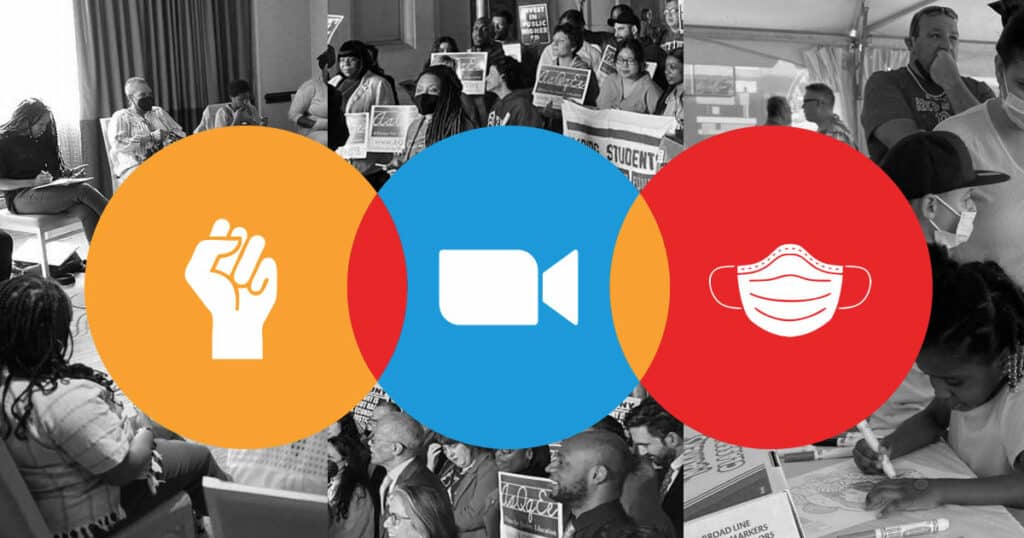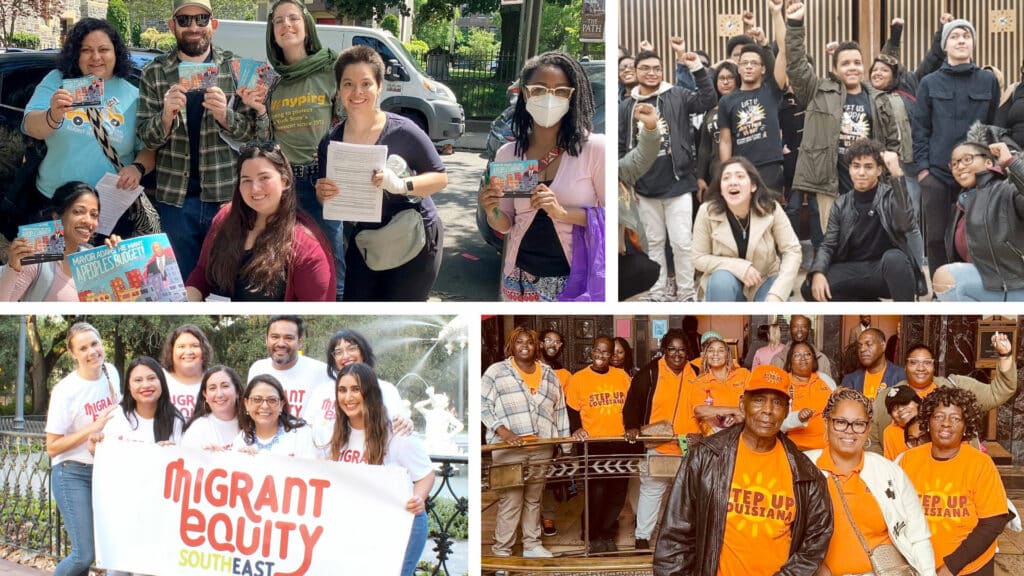Blog
Schott Summer School: How to Hold Events in the New Normal

This summer we’re releasing a series of deep dives into practical questions facing grassroots organizers, informed by our grantee partners across the country.
In-person events are becoming the norm again, and advocates in the education justice movement are taking the opportunity to experiment and innovate. How can the movement make its gatherings more inclusive, accessible, and meaningful? In a world of pandemics and Zoom rooms, and in an economy in which both time and space have become scarcer in working class communities, what lessons do we need to learn?
We’ve learned not just from our own experiences, but also from our grantee partners in the OTL Network — special thanks to the Alliance for Quality Education, Dignity in Schools Campaign, and Massachusetts Education Justice Alliance for sharing their insights, including:

Here are five key lessons we learned, and how you can apply them to your own practice:
1. Zoom fatigue is real, but not insurmountable
Several of our grantee partners have reported lowered registration and attendance rates to online meetings and events, especially over the past year. The 2020-era novelty of large Zoom meetings has worn off for many, which is both a cause and effect of the return of in-person events. Relatedly, a few of our grantee partners report that they’ve seen much larger than anticipated turnout for their in-person events.
This isn’t to say virtual events and large meetings are impossible, but the labor before and during has certainly risen. Ways you can battle Zoom fatigue:
- Send more email and text reminders in the days beforehand
- Take time for one-on-one outreach to prospective attendees if possible
- Shorten event duration
- Be clear on what attendees will get out of attending (e.g. they’ll receive important info, or offer their ideas, or participate in a crucial decision)
- Keep attendees engaged throughout, encouraging active use of chat features and structured breakout room time
2. Use hybrid events to meet people where they are
Hybrid events, in which some attendees are join virtually and others join in-person, are becoming a new normal for grassroots organizations — especially those with a wide and distributed membership. The reasons for going hybrid are numerous: perhaps to accommodate attendees who are immunocompromised, or are too far away to make the travel worth it, or have tight and conflicting schedules, or are not yet fully committed to the organization or event (e.g. a general interest meeting).
 DSC’s Tafari Melisizwe says, “How do we ensure that the care in word matches the care in practice — folks who may be immunocompromised, dealing with health issues, folks who have anxiety about being out in public spaces again?”
DSC’s Tafari Melisizwe says, “How do we ensure that the care in word matches the care in practice — folks who may be immunocompromised, dealing with health issues, folks who have anxiety about being out in public spaces again?”
Hybrid events can be configured in numerous ways, including:
- A few virtual attendees to a mostly in-person event. The primary challenge is for virtual attendees to properly see and hear the other participants. Microphones at the venue will likely be necessary.
- A small group joins a larger virtual event. The primary challenge is for those in the small group to each be able to participate fully, in chat windows, voting, and Q&A. Facilitators should take special care to ensure that everyone in those small groups are included as fully as other virtual participants.
- Pod-style events, in which smaller groups meet in person at different location and only join virtually for larger discussions, report-backs, and decisions. This is an especially useful method for chapter-based organizations, which in effect makes the “breakout group” the norm rather than the exception. The primary challenge is the difficulty of cross-pollination between groups — and, depending on group sizes and venues, the need for additional A/V tech at each pod.
While they can be versatile, hybrid events can also be twice as difficult to organize as a solely virtual or solely in-person event.
Some groups have dedicated tech line items in their budgets to ensure that all their members can fully participate. Purchases can include laptops, microphones, web cameras, quality bridge-style group microphone/speakers, and projectors.
3. Multilingual accessibility should be planned from the start, not an afterthought
One of the unalloyed goods of the Zoom era is the relative ease of live captioning and language interpretation with virtual events. Especially for groups working in immigrant communities, the ability for virtual attendees to switch languages with the click of a mouse has been a game changer. As Tafari Melisizwe puts it, “Organizing doesn’t only happen in English. The flow of ideas doesn’t only happen in English.”
Offering multiple languages should not be considered an add-on: to do live interpretation correctly, it needs to be baked into your event planning process from the start. Here are lessons our grassroots partners have learned:
- Always have more than one interpreter on hand for each language for an event. Live interpretation, be it into another verbal language or ASL, is difficult work. Those doing so will need to take breaks. And AQE Executive Director Jasmine Gripper reminds us to have backups for our backups: “Having a rolling list of a lot of interpreters is important. Because what happens when you only have two and you have an event and they’re not available? We have a plan B, C, and D at this point, because we’ve had times when another group was using that person, because a lot of us know the same interpreters.”
- Adjust your meeting agenda. Speakers will need to speak more slowly and deliberately and will need to have a way to be informed that they need to pause or repeat themselves.
- Ensure that interpretation is a two-way street. It’s not enough for participants to be able to listen to an English-speaker in Spanish: for an actually inclusive event, Spanish speakers must be able to speak and ask questions too.
 Build relationships with interpreters and interpreter groups. Connect with similar organizations to see who they use for interpretation, ideally building a call list of interpreters. MEJA Executive Director Vatsady Sivongxay says, “many of our progressive organizations share a list of interpreters and translators, and update that list together,” and that the groups often share interpreter materials and equipment.
Build relationships with interpreters and interpreter groups. Connect with similar organizations to see who they use for interpretation, ideally building a call list of interpreters. MEJA Executive Director Vatsady Sivongxay says, “many of our progressive organizations share a list of interpreters and translators, and update that list together,” and that the groups often share interpreter materials and equipment.- Pay them well and appreciate them. Live interpretation is skilled labor, and should be budgeted for as such. Try not to rely on volunteer interpretation done by organization members except in emergencies. Take time out of each meeting to recognize and applaud their work.
- Do a dry run to make sure the tech works. For virtual events, ensure that alternative language channels are working and there are no technical issues for the interpreters. For in-person events, test head sets for speakers and participants for signal quality and have extra batteries on hand.
4. Anticipate attendees’ needs
There will always be more people who’d like to attend an event than actually do — groups in touch with their members and the larger community can shrink that difference by better understanding barriers to attendance and resolving them. The question “why aren’t more people coming to our events?” isn’t answered by those who are there.
 Offer childcare on-site — and off-site. Groups have long recognized that a lack of childcare is a perennial barrier to participation in events, only made worse by skyrocketing childcare costs across the country. For in-person events, look for a venue with a dedicated space. “This way, the parents can actually focus because they’re not distracted at the corner or in the back,” Jasmine Gripper says. Many groups offer childcare stipends for members who are attending virtually.
Offer childcare on-site — and off-site. Groups have long recognized that a lack of childcare is a perennial barrier to participation in events, only made worse by skyrocketing childcare costs across the country. For in-person events, look for a venue with a dedicated space. “This way, the parents can actually focus because they’re not distracted at the corner or in the back,” Jasmine Gripper says. Many groups offer childcare stipends for members who are attending virtually.- Feed the people. Food is the most compelling inducement for attendance. Groups report moving more toward individually wrapped food offerings for health and cleanliness. Statewide groups like AQE have also identified that long commutes to and from events should also be taken into consideration: even if a rally or forum ends before dinner, will they be getting home late at night if they have to take a bus for several hours?
- Provide COVID precautions. Many organizations continue to offer free masks, hand sanitizer, and prioritize either outdoor spaces or well-ventilated venues. DSC has invested in portable air purifiers that they can take with them to events. Depending on the nature and scale of the event, some groups ask participants to take a rapid test that morning.
5. Make debriefs count — internally and externally
Some of the most important insights groups have learned came from feedback from participants.
- Provide multiple paths for attendee feedback. If online, create a simple form, but also provide an email address. In person, offer printed feedback forms and at least one way they can digitally reach out later.
- Ask for feedback from those who registered but didn’t attend. You may be surprised by the barriers keeping people from attending.
- Have internal debriefs as soon after the event as possible. For AQE, debriefs are best while the event is still fresh in mind. “On Zoom, we just stay on and do it right there. Even if it’s an evening one, we just do a quick highlights and deltas session.” For larger events, especially those done in coalition with other organizations, longer and multiple debriefs are likely in order.
Additional Resources
- Download the new HEAL Together Organizing & Narrative Toolkit, which includes practical tips on planning and running meetings large and small.
- Review Young People For’s Event Planning Toolkit [PDF]
- Check out the Electronic Frontier Foundation’s Tips for Organizing Public Events


